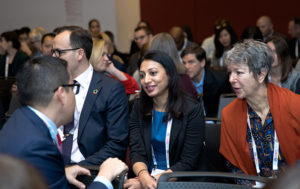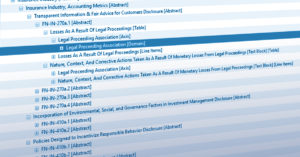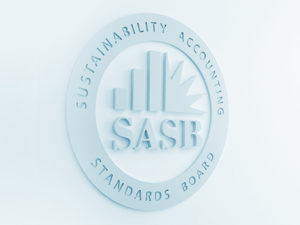On November 30 and December 1, more than 1,000 attendees from 33 countries convened at the virtual SASB Symposium to discuss the future of ESG disclosure for the capital markets. As 2020 was a watershed year for sustainability disclosure—one in which the world’s largest investors, the world’s largest companies, and leading regulators all recognised the need for improvement—there was plenty to discuss. Here are key takeaways from some of the mainstage sessions.
A Vision for Resilient & Sustainable Capital Markets
In the opening keynote, Brian Moynihan, CEO of Bank of America and Larry Fink, CEO of BlackRock, highlighted the importance of stakeholder capitalism.
“The idea that just having one stakeholder – the shareholder – has evolved,” Fink said. “Working with employees, being connected to clients, and working with the societies where you operate is becoming more and more important. Companies focusing on all stakeholders are the companies that can have durable, long-term profitability.”
Moynihan added that companies must deliver for both shareholders and society in general. “Our investors, clients and teammates are demanding this of us.”
Moderator Janine Guillot, CEO of SASB, asked why corporate disclosure was so important to these efforts.
“Companies evolve faster through disclosure,” Fink said. “Transparency reveals the good and bad parts of everyone. Better financial disclosure forces management and the board to have a greater laser focus on these issues.”
Disclosure can be a positive incentive, said Moynihan. “It enables companies to prove they are doing what they say, which allows us to invest in them. We need people to see what they are doing so they can be encouraged to do more. If big companies are doing it, it will cascade down the system because customers and employees will demand it.”
Moynihan talked about his role as Chair of the World Economic Forum’s International Business Council, which produced universal stakeholder capitalism metrics that allow companies to set goals, demonstrate value, drive progress on achieving the SDGs, he said. The SASB Standards are additive to the IBC metrics—by using both together, companies can provide a comprehensive picture of performance.
Investment in sustainability is accelerating because companies are examining and publishing their sustainability risks. “I have never seen change so rapid as now and it is because of disclosure. Stakeholder capitalism is alive, well, and flourishing. We’re going to change the course of investment through better disclosure and better data,” said Fink. “We want more companies to report through SASB and TCFD.”
International Summit: Toward a Global System for Non-Financial Disclosure
Introducing the second session, moderator Mary Schapiro, Vice Chair for Global Public Policy at Bloomberg, head of the TCFD Secretariat and the former Chair of the US SEC, highlighted the significant changes that have happened this year in the non-financial disclosure field.
The European Union is reviewing its Non-Financial Reporting Directive; the IFRS Foundation has announced a consultation on sustainability reporting; SASB, GRI, CDSB, CDP and IIRC have published their shared vision paper; and SASB and the IIRC have announced their intent to merge.
The update of the EU Non-Financial Reporting Directive is part of a set of broader policies on sustainability, sustainable finance, and climate change, said Alain Deckers, Head of Unit, European Commission, DG FISMA (Directorate‑General for Financial Stability, Financial Services, and Capital Markets Union). “There are two main objectives – to reinforce investor protection and to ensure a strong basis for public accountability,” he said.
“We need to ensure investors receive the information they need on the risks and opportunities related to sustainability. We want to avoid greenwashing. To ensure that disclosure is credible, we must ensure that the information is right.”
Erkki Liikanen, IFRS Foundation Trustees Chair, said the Foundation is considering establishing a Sustainability Standards Board to sit alongside the International Accounting Standards Board “but to be successful, we need support from public authorities, global regulators, and other stakeholders.”
It is proposed the new board would initially focus on the issues most relevant to investors. “The process should build gradually. The consultation paper proposes to start with a focus on climate-related reporting standards. Why climate first? The issue is urgent. More than 100 regulators and government entities support TCFD and it has created an initial framework.”
As sustainability has grown in importance, its connection to the core missions of securities regulators has become more and more apparent, said Erik Thedéen, Chair of the Task Force on Sustainable Finance at IOSCO. But a fragmentation of standards and lack of auditing raises the risk that companies would cherry pick the aspects that suited them. “The financial community asked IOSCO to get involved to help harmonization and make standards more comparable,” he added.
“This issue is now core to what regulators are doing. The momentum is really positive,” he said, explaining that IOSCO is exploring how to create an architecture for non-financial disclosure that enables regional initiatives such as the EU’s to interact with global bodies.
The SEC must become more engaged on the issue “and swiftly,” said SEC Commissioner Allison Herren Lee, Commissioner, US Securities and Exchange Commission, speaking only on her own behalf. While investor demand has led to significant progress on climate-related disclosure, “we are reaching or have reached a tipping point on the efficacy of a voluntary regime,” she said. “There are a number of standards out there. Companies are dealing with conflicting requests and investors are not getting the information they need. I’m not convinced we can achieve a standardised approach without regulatory involvement. There are questions over the reliability of voluntary information. I hope that we will see swift and thorough attention to this.”
There is considerable appetite among Japanese companies and all other relevant stakeholders for more disclosure and engagement with standard setting processes, said Makoto Sonoda, Director for International Accounting and Director for International Capital Market Regulation at FSA Japan.
“Sometimes the government encourages the private sector to move towards this type of new framework, but with the TCFD, the impetus is totally coming from the private sector.”
From Alphabet Soup to Unified System
The work of the ‘group of five’ standard setters set out a vision for comprehensive corporate reporting system, culminating in the joint statement of intent that was issued in September. “It became clear through that work that three organisations had very similar conceptual underpinnings – SASB, IIRC and CDSB,” said Guillot. By integrating two entities that are focused on enterprise value creation, the IIRC-SASB merger represents significant progress towards simplifying the corporate reporting landscape.
Moderator Bob Eccles, Visiting Professor of Management Practice at Saïd Business School, pointed out that things are moving very quickly. “We are moving now in the direction of having global standards that will be regulated. There’s pretty strong global support for a set of regulated standards with reporting requirements.”
CDSB Managing Director Mardi McBrien said that on reporting, “we need pace, we need scale, and we need this to happen fast. The only way to get that is not just global consensus but to make it mandatory.”
Paul Simpson, CEO of CDP, said that he preferred to characterize the current system as “market-led rather than voluntary”, adding that “most regulators will only regulate when there is market consensus. We can go to the regulators and show that investors require this, companies can do it and it will lead to more sustainable capital markets and a more sustainable economy.”
The financial accounting standards are a good model, Guillot said. “The regulator doesn’t prescribe every single aspect of disclosure but does reference the accounting standard setters. That way you get the best of both worlds – the flexibility of a market-oriented solution with the consistency and comparability that comes from regulators acknowledging standards.”
Reporting to multiple stakeholders on impacts on society is equally important to reporting to investors on long-term enterprise value creation. “We need to work on that bridge of understanding, of collaboration, so we have a set of standards that meet the needs of stakeholders, policymakers, and investors,” said Eric Hespenheide, Chairman of the Board of Directors at GRI.
Global Investor Momentum: Why ESG is no longer an optional-long-term strategy
Over the last few years, both asset owners and asset managers have been looking to express themselves on issues such as climate change, and that pace has been accelerating in the run-up to COP26, said Margaret Franklin, President and CEO of the CFA Institute. “The financial world is meeting the real world. This movement is being led by asset owners, particularly universal owners, where they have a very long-term time horizon,” she said.
ESG issues are an increasing factor in investment risks and opportunities and regulators in some parts of the world have signaled they are looking for more ESG metrics, said Cyrus Taraporevala, President & Chief Executive Officer of State Street Global Advisors. For asset managers, this is a fiduciary issue, he added. “We have to think about how to get the best risk-adjusted returns for our asset owners. For us, ESG is about value, not values.”
Data is the right tool to help address these issues, said moderator Robert Steel, Chairman at Perella Weinberg Partners.
Taraporevala welcomed the SASB/IIRC merger, saying: “If we can get the entire [investment] industry to coalesce around one set of data, metrics and methodology, not only will it make it easier for us as investors, it will help portfolio companies, too. They are being driven nuts by the fact that they have to produce hundreds, if not thousands of different metrics because there is no commonality.”
The merger allows a common language to develop, agreed Steel, and “serves as a lubricant for success.”
Thank you to all the speakers, sponsors, and attendees who made this year’s symposium a success! We will see you in 2021.


